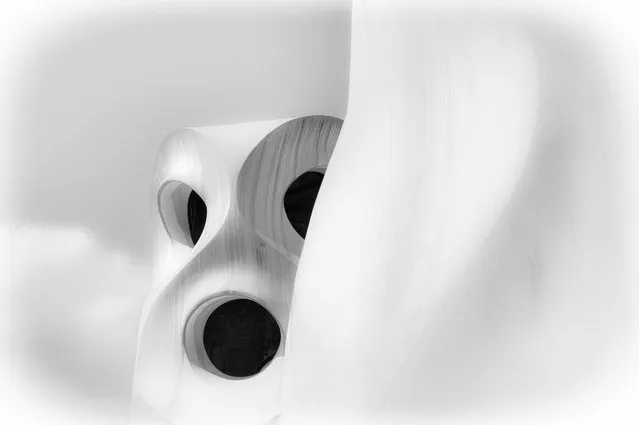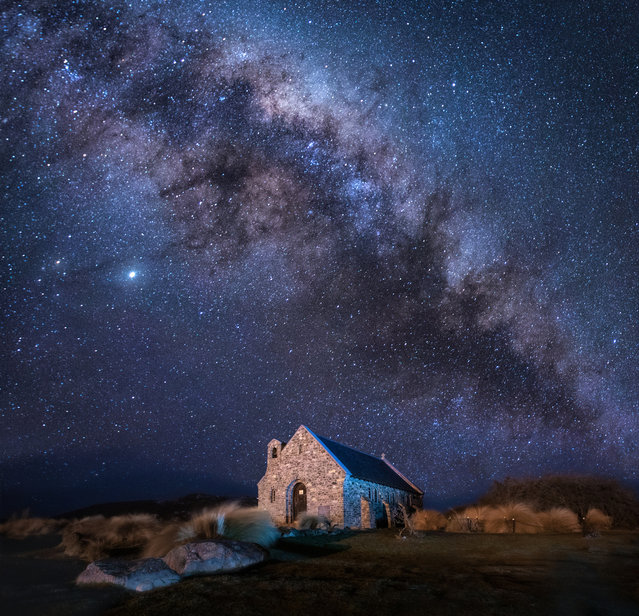
Winner: Where History Happened, Palmyra, Syria. “This image was taken before the civil war in Syria at the ancient city of Apamea. I’d dragged my family out of bed early, when it was cold and dark, to ensure we were at the Great Colonnade early enough to catch sunrise and the golden hour. I’d got my timings wrong and we were an hour early so sat around wondering where the sun had gone and waiting for dawn. It was worth the wait. I felt privileged at the time to have the opportunity to visit Apamea, but even more so since the civil war damaged some of these most impressive monuments”. (Photo by Martin Chamberlain/Historic Photographer of the Year 2020)

Winner: Historic England, St Michael’s Church. St Michael’s church on Burrow Mump, surrounded by a blanket of mist. Burrowbridge, Somerset, England. December 2019. (Photo by Adam Burton/Historic Photographer of the Year 2020)

Shortlisted: The Wreck SS Denham. “On my photographic journey I love to visit various places across the north-west of England. On this occasion this was the remains and site of a second world war vessel called the SS Denham. I created a video/vlog and images of the site”. (Photo by Mali Davies Photography/Historic Photographer of the Year 2020)

Shortlisted: Callanish Standing Stones. Callanish on the Isle of Lewis, Scotland at sunrise a few days before the winter solstice. (Photo by Dawn Louise Farrell/Historic Photographer of the Year 2020)

Shortlisted: Citadel of Alessandria, Italy. This was taken in the basement of the abandoned Citadel of Alessandria. Years ago, the river in the city flooded the basement of the complex. The floor as you see it in this photo is a remainder of that. It is dried mud. The Citadel of Alessandria was built by Carlo Emanuele III, the King of Sardinia, in 1732 and terminated by Napoleon in 1808. With its 74 hectares it represents one of the greatest examples of an 18th-century fortification with bastions in Europe and one of the few that exist today. (Photo by Roman Robroek/Historic Photographer of the Year 2020)

Shortlisted: The Maunsell Forts, Thames Estuary, Kent. Shot taken from a helicopter of Red Sands Maunsell forts. The Maunsell naval forts were built in the Thames estuary and operated by the Royal Navy to deter and report German air raids during the second world war. (Photo by Michael Marsh/Historic Photographer of the Year 2020)

Gaudi’s chimney, Casa Milà (La Pedrera), Barcelona. The building was commissioned in 1906, designed by architect Antoni Gaudí and was built between 1906 and 1912. It was designated a historic and artistic monument on 24 July 1969. (Photo by Juliet Evans/Historic Photographer of the Year 2020)

Shortlisted: Ladybower Plugs. Beautiful scenery of the Derwent area; including the reservoir plugs of the Ladybower. (Photo by Jo Emery/Historic Photographer of the Year 2020)

Shortlisted: Welsh Farmhouse. A deserted farmhouse in Wales. The ceilings are caving in but the room is filled with a family’s history. (Photo by Ian M. Hazeldine/Historic Photographer of the Year 2020)

Shortlisted: St Basil’s Cathedral, Red Square, Moscow. Cathedral of the Intercession of the Blessed Virgin Mary, on the Moat – an Orthodox church on Red Square in Moscow, a monument of Russian architecture. The construction of the cathedral was carried out from 1555 to 1561. The cathedral unites 11 churches, some of which are consecrated in honour of the saints, whose days of memory fell on the decisive battles for Kazan. The photo shows cadets of one of the Moscow military universities participating in the reconstruction of the parade on 7 November 1941. (Photo by Dmitry Bogdanov/Historic Photographer of the Year 2020)

Shortlisted: Taj Mahal. Sunrise at the Taj Mahal, India. (Photo by Gillian McDonald/Historic Photographer of the Year 2020)

Shortlisted: Hadleigh Castle ruins. “This was once an important economic and defensive castle built during the reign of Henry III. It shines, once more, under the bright stars of the night sky as a drone passes by”. (Photo by Diana Buzoianu/Historic Photographer of the Year 2020)

Shortlisted: Badbury Rings. “Badbury Rings is one of several large hill forts constructed in the first century BC by the Durotriges tribe. No one knows for sure why these Iron Age traders felt the need to erect such formidable defences; it may have been a response to the political instability resulting from the northward advance of Roman influence through Gaul (France). The Romans’ insatiable demand for slaves could well have placed the Britons at risk from raids, and these great ramparts and ditches would have deterred attacks by tribes from the east. Whatever inspired their creation, the concentric rings stand as a dramatic reminder of the wealth and power the Durotriges derived from trade with the Armoricans of Brittany, based around the harbours at nearby Hengitsbury Head. Shot at dawn using a drone, this image reveals the site in the context of its landscape. Visible on the horizon is Poole Harbour, which was a major centre for ceramics in the decades before the Roman invasion of AD43, in the wake of which Badbury was deserted”. (Photo by David Abram/Historic Photographer of the Year 2020)

Shortlisted: Church of the Good Shepherd, New Zealand. “Church of the Good Shepherd under the stars. The sky of the southern hemisphere is incredibly beautiful. You should go to the other end of the planet to see it with your own eyes. It doesn’t matter that the forecast promised a clear sky but outside the window it was icy rain and gale-force winds. For the sake of such a sky it is worth the wait. Patience is always rewarded. The clouds soon dispersed and opened the way to space”. (Photo by Elana Pakhalyuk/Historic Photographer of the Year 2020)

Shortlisted: Poulnabrone Dolmen. “I went to Poulnabrone Dolmen in County Clare in Ireland at sunset”. (Photo by Todor Tilev/Historic Photographer of the Year 2020)

Shortlisted: Whitby Abbey. “I was born in Whitby and lived there until the age of 21. I spent many wonderful years visiting the historic treasures that Whitby has to offer, nothing more iconic than the abbey that towers over the town’s harbour. Now living in Lincoln, I get back as often as I can to see family but to also photograph some of the beautiful places it has to offer”. (Photo by James Smith/Historic Photographer of the Year 2020)

Restormel Castle surrounded by morning mist, Lostwithiel, Cornwall, England. Autumn (October) 2019. (Photo by Adam Burton/Historic Photographer of the Year 2020)

Overall Winner: The Brighton Palace Pier. “Standing in the full force of weather and time: the Brighton Palace Pier. My wife and I have been visiting Brighton for a few years now and I always strive to capture this lovely historic seaside town with a sense of the atmosphere and cinematic interpretation that it instills in me”. (Photo by Michael Marsh/Historic Photographer of the Year 2020)
27 Nov 2020 00:03:00,
post received
0 comments
